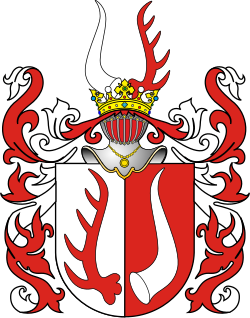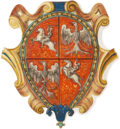| Rogala | |
|---|---|
 | |
| Details | |
| Alternative names | Czabory, Celbarz |
| Earliest mention | 1109 |
| Families | Armański, Bajewski, Bandorski, Bech, Bech, Bechowski, Becke, Bendorski, Bielanowski, Bieniecki, Bobola, Bolko, Bolszewski, Bolszowski, Bołoto, Borowski, Brodzyński, Brzeżański, Budlewski, Butkowski, Charbaszewski, Charmański, Charytonienko, Chinowski, Chormański, Chrzanowski, Chądzyński, Chynowski, Cielemęcki, Cieśliński, Czachorowski, Czambor, Czarnocki, Czartkowski, Dawidowicz, Dobrzyszewski, Drogosz, Duczymiński, Eumanow, Filcz, Fuliński, Głuchowski, Głuszyński, Górski, Grabowieński, Grunenberg, Harbaszewski, Hermanowski, Hermeus, Hirosz, Hodicki, Iwan, Iwanowski, Jarzecki, Jarzęcki, Jarzycki, Jeziorski, Jezierski (Ežerskis), Jutowski, Jutrowski, Kaczorowski, Kałuski, Karniewski, Każniewski, Kaźniewski, Kiciński, Kiełpiński, Kiłdysz, Kobrzyński, Kocieński, Koczorowski, Kolbrzyński, Kolczyński, Koliczewski, Koliczkowski, Kolitowski, Kosieński, Kosiński, Kostecki, Kostkiewicz, Kościeński, Krasicki, Krasowski, Krassowski, Kulczyński, Kuliczkowski, Kummern, Kunstetter, Kurosz, Kurski, Kuwieczyński, Lapanowski, Lechwal, Lewald, Lewalt, Lewicki, Lewoniewicz, Lgocki, Lipski, Lissonicki, Lissoniski, Loga, Loka, Lork, Lubonicki, Lubonidzki, Luboniecki, Luk, Luka, Lunowski, Łapanowski, Łapinoski, Łapinowski, Łazowski, Łosicki, Łosiecki, Łuka, Łysomicki, Machciński, Machnacki, Marciewski, Marczewski, Marusiewski, Maruszewski, Młodzianowski, Nakonieczny, Niczgórski, Niwicki, Nowicki, Odrzywolski, Oniśko, Orczyński, Orecha, Orechwa, Orzechowski, Osikowski, Oskolski, Osmolski, Pałukowski, Parafianowicz, Parafinowicz, Paruszewski, Pikulski, Pilchowski, Pilkiewicz, Pilko, Popiełowski, Poruć, Poruszewski, Powalski, Powołkowski, Powołowski, Punikiewski, Rajkowski, Rasiński, Raszyński,Raykowski, Rembiewski, Remiszowski, Rębiewski, Ręczajski, Ręczayski, Ręczyński, Rogala, Rogalewicz, Rogalewski, Rogaliński, Rogalski, Rogieński, Rogiński, Rogowicz, Rokicki, Rosocki, Rozwadowski, Różewski, Rudgierz, Ryński, Rzekiecki, Sanchocino, Sancugniewski, Sancugniowski, Seroczyński, Sidłowski, Sieciński, Sieczyński, Sierpiński, Skalski, Skałka, Skolski, Skomowski, Skromowski, Skulski, Słąkowski, Sobieszczański, Sobieściański, Sąchocki, Suchociński, Swaracki, Swarecki, Swarocki, Swierski, Szczygielski, Szwaracki, Szwaradzki, Targowski, Tatkiewicz, Tchorzewski, Tchórzewski, Trembiński, Trębiński, Trosiński, Troszyński, Trzylatkowski, Trzylątkowski, Turski, Tyrau, Uwieleński, Uwiliński, Wasilewski, Wencki, Wensło, Wentzki, Wessel, Węcki, Węgrzynowski, Wężeł, Wiśniewski, Witnikowicz, Wągrocki, Wągrodzki, Wybicki, Wydrażewski, Zaborowski, Zagorzycki, Zagórny, [1] [2] Zagórski, Zawadzki, Zembocki, Zębocki, Żarnowski, Żarnowski de Biberstein, Żernicki, Żyrnicki, Świerski, Świrski |
Rogala is a Polish coat of arms, likely based upon armorial bearings imported from Northeastern Germany to Poland around 1109, by members of the von Bibersztein family (whose arms feature a 5-tined stag's horn). Polish descendants of this family later added a second horn, that of the Urus or European Bison, to create the Rogala arms. [3] It was used by numerous szlachta families in the time of the Polish–Lithuanian Commonwealth.


